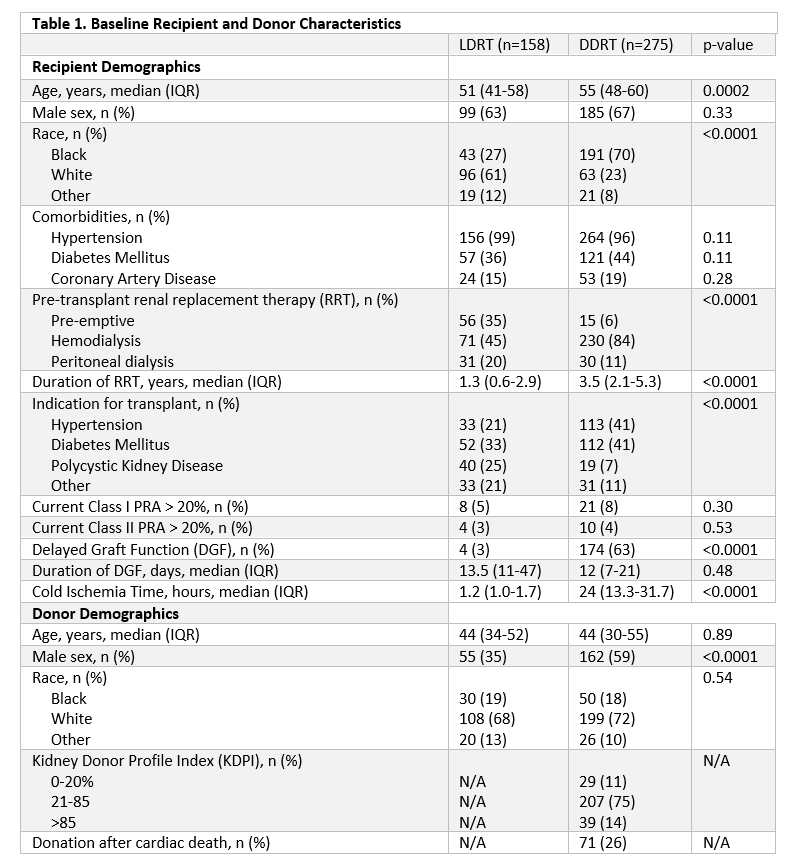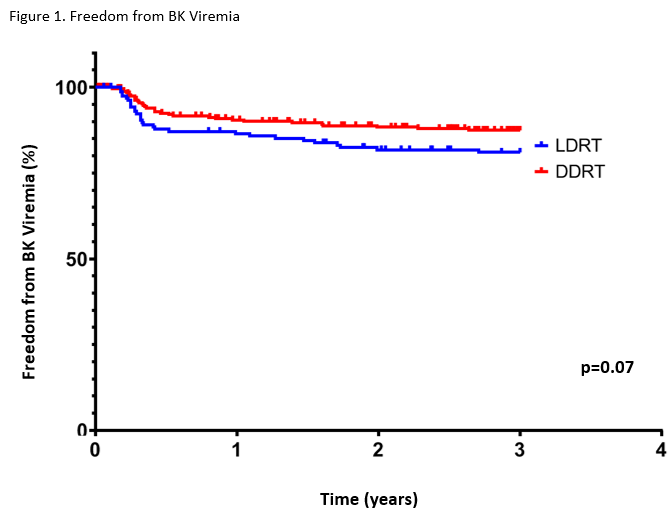BK Viremia in Living vs Deceased Donor Renal Transplant Recipients Receiving Alemtuzumab Induction
1University of Maryland Medical Center, Baltimore, MD, 2Univ of Maryland Schl of Med, Baltimore, MD
Meeting: 2022 American Transplant Congress
Abstract number: 1356
Keywords: Immunosuppression, Kidney transplantation, Living donor, Polyma virus
Topic: Clinical Science » Infection Disease » 26 - Kidney: Polyoma
Session Information
Session Time: 7:00pm-8:00pm
 Presentation Time: 7:00pm-8:00pm
Presentation Time: 7:00pm-8:00pm
Location: Hynes Halls C & D
*Purpose: There is conflicting data regarding the association of donor type and BK viremia in renal transplant recipients. This study sought to compare the incidence of BK viremia and associated complications between living donor renal transplant recipients (LDRT) and deceased donor renal transplant recipients (DDRT) with similar immunosuppression.
*Methods: This was a single center, retrospective review of adult LDRT and DDRT transplanted between 01/2012-09/2015. All patients received alemtuzumab induction with tacrolimus, mycophenolate, and corticosteroid withdrawal. Key endpoints included incidence of BK viremia, biopsy-proven BK nephropathy (BKVN), biopsy-proven acute rejection (BPAR), and patient and graft survival at 1 and 3 years post-transplant.
*Results: Baseline characteristics of the 433 included patients are listed in Table 1; observed differences were expected when comparing LDRT and DDRT related to pre-transplant renal replacement therapy and delayed graft function. The overall incidence of BK viremia in the entire cohort was 10.4% at 1 year and 14.1% at 3 years. BK viremia was numerically higher in LDRT at 1 and 3 years (13% vs 9%, p=0.24 and 18% vs 12%, p=0.05). The majority of patients developed BK viremia within 1 year post-transplant, with no difference in time to BK (Figure 1). There was no difference in BKVN between groups at 1 or 3 years, with a longer median time to BK clearance seen in DDRT (Table 2). Though no difference in AMR was observed, there was increased DSA formation in the DDRT group (Table 3).
*Conclusions: These data suggest there is no association observed between donor type and BK viremia in renal transplant recipients. Given a longer time to BK clearance in DDRT, this cohort should be closely monitored for immunosuppression adjustments to minimize risk of DSA formation.
To cite this abstract in AMA style:
Casale JP, Pluckrose D, Haririan A, Sparkes T. BK Viremia in Living vs Deceased Donor Renal Transplant Recipients Receiving Alemtuzumab Induction [abstract]. Am J Transplant. 2022; 22 (suppl 3). https://atcmeetingabstracts.com/abstract/bk-viremia-in-living-vs-deceased-donor-renal-transplant-recipients-receiving-alemtuzumab-induction/. Accessed December 28, 2025.« Back to 2022 American Transplant Congress



